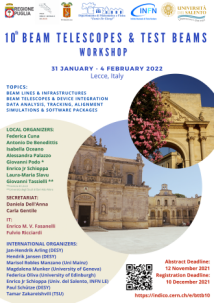Speaker
Description
The High-Luminosity LHC (HL-LHC) will deliver proton-proton collisions at 5-7.5 times the nominal LHC luminosity, with an expected number of 140-200 pp-interactions per bunch crossing. To maintain the performance of muon triggering and reconstruction under high background radiation, the forward part of the Muon spectrometer of the CMS experiment will be upgraded with Gas Electron Multiplier (GEM) and improved RPC (iRPC) detectors. A first GEM station (GE1/1) was installed during long-shutdown 2 LS-2), a 2nd station (GE2/1) of Triple-GEM detectors will be installed in the year end technical stops of 2023-2024 or 2024-2025, while a new 6-layer station (ME0) will be installed in the third long shutdown (LS3) 2026-2028. The lessons learnt with the first large-area GEM station have lead to improvements in detector and electronics design. For the first time we made a test of the full readout chain, using final detectors, electronics and DAQ. A production GE2/1 chamber was tested with muons and pions at CERN SPS toghether with a prototype ME0 chamber. The detectors were equipped with their final front-end electronics, sending data over optical fibers to the FPGA DAQ board operating the standard CMS DAQ software. A new beam telescope based on 4 Triple-GEM detectors with fine pitch and 70um spatial resolution obtained through digital readout was tested. We will present GEM chamber and telescope performance during beam tests, with particular emphasis on spatial resolution and rate capability.
